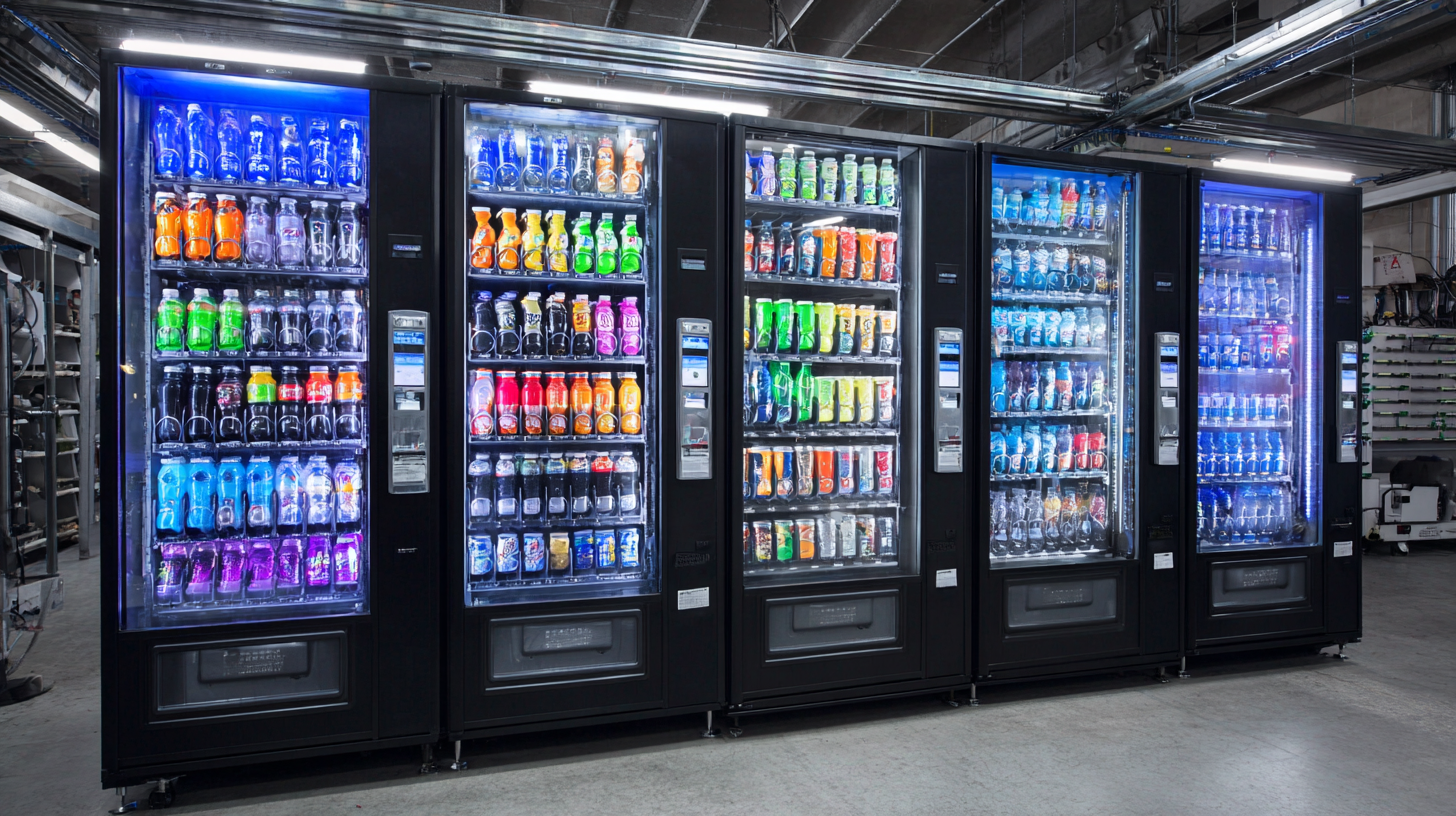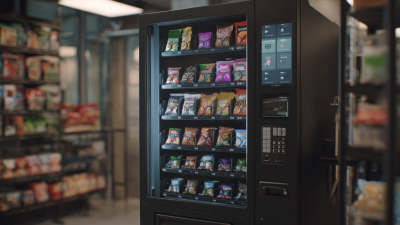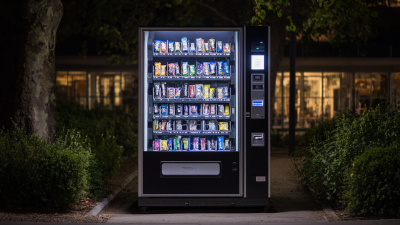Unlocking Profits: How the Vending Machine Business Rakes in $7 Billion Annually with Smart Tech
In today’s fast-paced world, convenience and efficiency are paramount, making vending machine businesses an increasingly lucrative sector within the retail industry. Generating an astonishing $7 billion annually, these automated retailers are not merely relics of the past; they are evolving through smart technology to meet the demands of modern consumers.
 With advancements such as cashless payment options, personalized product recommendations, and real-time inventory tracking, vending machines are enhancing the shopping experience while maximizing profits. This article explores the innovative strategies employed by successful vending machine businesses that transform them into profitable enterprises, highlighting how they leverage technology to captivate a diverse customer base and stay competitive in an ever-changing market landscape.
With advancements such as cashless payment options, personalized product recommendations, and real-time inventory tracking, vending machines are enhancing the shopping experience while maximizing profits. This article explores the innovative strategies employed by successful vending machine businesses that transform them into profitable enterprises, highlighting how they leverage technology to captivate a diverse customer base and stay competitive in an ever-changing market landscape.
The Rise of Smart Technology in the Vending Machine Industry
The integration of smart technology in the vending machine industry is revolutionizing the way consumers interact with these convenient retail options. According to a report by Research and Markets, the global smart vending machine market is expected to reach $14.5 billion by 2026, growing at a CAGR of 18.3%. This surge in growth is driven by the increasing demand for cashless payment systems and IoT-enabled features, allowing operators to monitor inventory in real-time and adjust offerings based on consumer preferences.
One notable advancement is the use of artificial intelligence to optimize stock management and enhance customer engagement. A survey conducted by the National Automatic Merchandising Association (NAMA) indicates that 61% of vending operators are now utilizing technology for inventory tracking and sales analysis. This data not only helps in reducing waste but also improves the overall customer experience by ensuring popular items are always available. As smart technology continues to evolve, vending machines are transforming from passive sellers into dynamic retailers, capable of adapting to changing consumer habits and preferences.
Innovative Features Driving Customer Engagement and Sales
The vending machine industry is experiencing a significant transformation, with innovative features that are enhancing customer engagement and driving sales. Smart technology, such as touchless payment systems and real-time inventory tracking, is not only modernizing the vending experience but also making it more convenient for customers. This technological evolution allows operators to respond quickly to consumer preferences and ensure popular items are always stocked.

To leverage these advancements, businesses in the vending machine sector should consider a few key strategies.
Tips:
- Utilize AI to analyze purchasing patterns and optimize product offerings based on customer demand.
- Implement engaging marketing campaigns that promote new features or seasonal products to keep the brand top-of-mind for consumers.
Additionally, offering personalized experiences through smart tech can significantly enhance customer loyalty. Vending machines equipped with interactive screens can provide nutritional information, suggest complementary products, or even reward points for repeat purchases, which keeps customers coming back. By focusing on innovation and customer engagement, the vending machine business is well-positioned to continue its impressive growth trajectory.
Maximizing Revenue: Strategic Location and Product Selection
Strategic location and thoughtful product selection play crucial roles in the profitability of the $7 billion vending machine industry. According to a 2023 IBISWorld report, the vending machine market is projected to continue growing due to evolving consumer preferences and advancing technology. Businesses that place their machines in high-traffic areas—such as office buildings, schools, and transportation hubs—can expect to see increased sales. High visibility and accessibility are key, as consumers are more likely to choose a vending machine that's convenient to them.
Tip: When considering location, assess foot traffic patterns during peak hours. Areas with heavy daily commuters or students can offer substantial opportunities.
Additionally, selecting the right products can significantly impact revenue. Research indicates that healthier snack options and popular beverages like energy drinks and flavored waters can attract a wider customer base. In fact, a survey conducted by the National Automatic Merchandising Association revealed that 70% of consumers prefer vending machines stocked with healthy items.
Tip: Regularly analyze sales data to identify trends in consumer preferences, allowing for timely adjustments to the product mix that can enhance profitability. By aligning product offerings with what customers want, businesses can boost their chances of maximizing revenue.

Data Analytics: How Insights Transform Vending Machine Operations
Data analytics is revolutionizing the vending machine industry by providing deeper insights into consumer behavior and operational efficiency. With the emergence of intelligent vending machines, operators can access real-time data on product sales, inventory levels, and customer preferences. This helps in tailoring product offerings to meet local demand, ultimately driving profitability. For instance, trends indicate that automated solutions are increasingly preferred by consumers, leading to significant growth in markets such as Japan, where the vending machine sector is expected to reach $1.067 billion by 2032.
The adoption of technological advancements like AI and cashless payment systems is further propelling the industry forward. These innovations not only streamline transactions but also enhance the overall customer experience. As the global vending market is projected to hit $104 billion by 2033, insights derived from data analytics will play a crucial role in shaping product strategies and optimizing supply chains, thus ensuring sustained growth. In the context of North America's intelligent vending machine market, the growth forecast highlights the transformative power of data in creating more responsive and profitable vending operations.
Future Trends: The Next Evolution in Vending Machine Profitability
The vending machine industry is on the cusp of a significant transformation, driven by advancements in technology and a shift in consumer preferences. As customers increasingly seek convenience and personalized experiences, smart vending machines equipped with artificial intelligence and IoT capabilities are emerging as game-changers. These machines not only offer a wider variety of products but also collect data on consumer behavior, enabling operators to tailor their offerings in real-time. This level of adaptability is crucial in maintaining customer interest and maximizing sales.
Moreover, the integration of cashless payment options is revolutionizing the vending experience. With contactless payment methods and mobile wallet applications becoming the norm, consumers can quickly and easily make purchases without carrying cash. This trend not only enhances user convenience but also increases transaction security. As vending machine operators embrace these technologies, we can expect to see a rise in overall profitability, positioning the industry for sustainable growth in the years ahead. Future trends indicate that the combination of smart technology and consumer-centric services will drive further innovations, unlocking new revenue streams and solidifying the vending machine's place in modern retail.
Unlocking Profits: How the Vending Machine Business Rakes in $7 Billion Annually with Smart Tech - Future Trends: The Next Evolution in Vending Machine Profitability
| Dimension | Value |
|---|---|
| Annual Revenue (USD) | $7 Billion |
| Number of Vending Machines (Estimated) | 3.5 Million |
| Average Annual Revenue per Machine (USD) | $2,000 |
| Percentage of Smart Vending Machines | 30% |
| Projected Growth Rate (Next 5 Years) | 8% CAGR |
| Top Categories in Vending Machines | Snacks, Beverages, Health Products |
| Common Payment Methods | Cash, Credit/Debit Cards, Mobile Payments |
| Most Popular Vending Machine Location | Offices and Educational Institutions |
Related Posts
-

Unlocking the Secrets of the Vending Business with 5 Key Strategies for Success in 2024
-

Maximizing Revenue with Vending Machine Support Trends and Insights from 2023
-

Understanding the Evolution of Vending Equipment and Its Impact on Modern Retail
-

Unlocking Efficiency: The Rise of Combination Vending Machines in a $30 Billion Industry
-

Exploring the Future of Vending Equipment in Automated Retail Solutions
-

Unlocking the Future: How Smart Vending Solutions Transform Consumer Convenience
